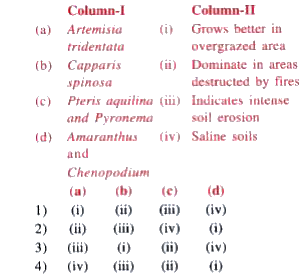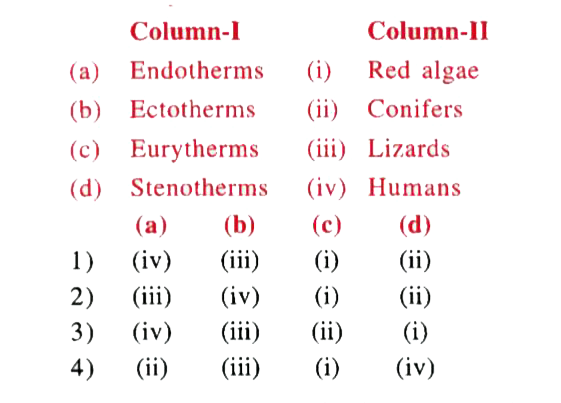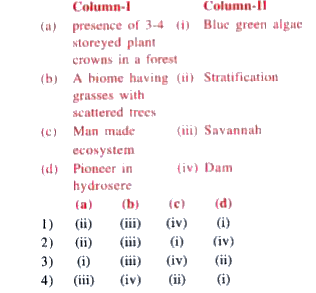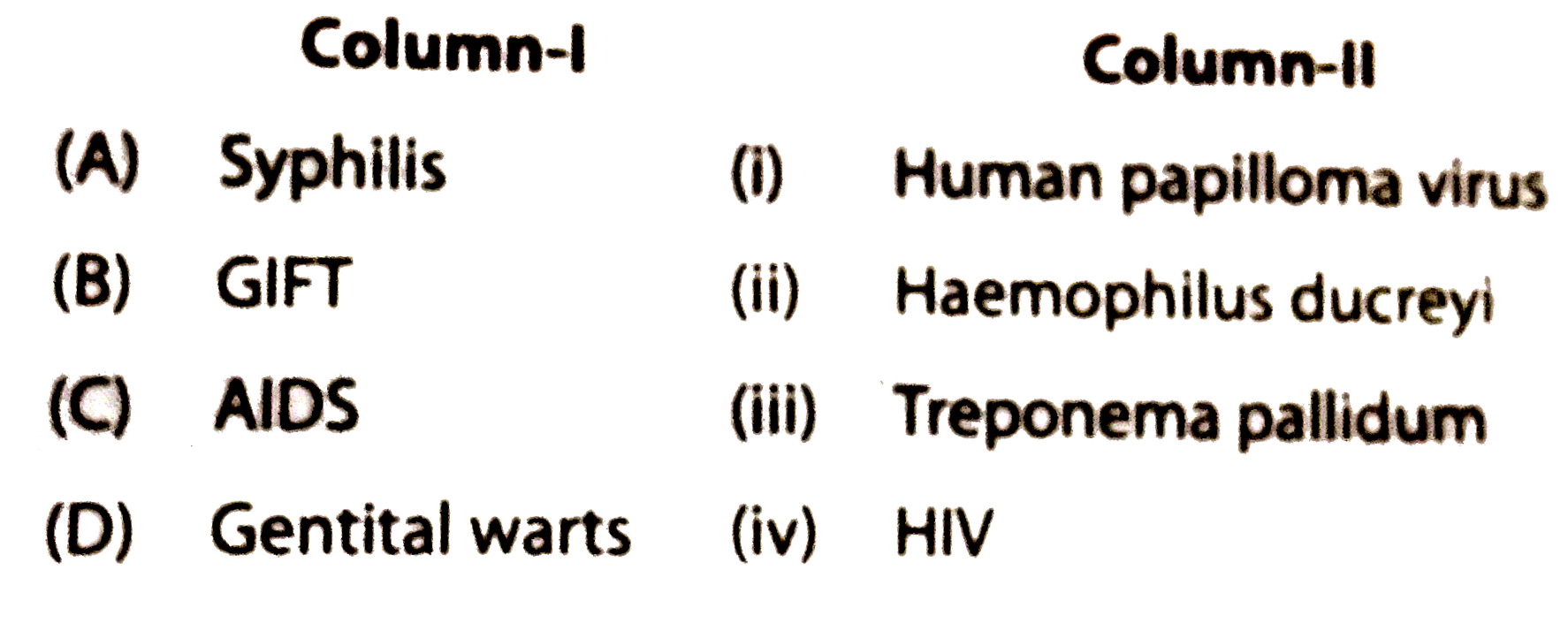Match the animal names listed under Column - I with the locomotor structure given under Column - II and select the correct option from the codes given below .
Column-IColumn-II(a)Nereis(i)Tube feet(b)Pleurobrachia(ii)Foot(c)Asterias(iii)Parapodia(d)Pila(iv)Comb plates
(a)(b)(c)(d)(iv)(iii)(i)(ii)
(a)(b)(c)(d)(iii)(iv)(i)(ii)
(a)(b)(c)(d)(iii)(iv)(ii)(i)
(a)(b)(c)(d)(iii)(i)(iv)(ii)
The correct Answer is:B
To solve the matching question between the animals in Column-I and their locomotor structures in Column-II, we will follow these steps:
Step 1: Identify the Animal Groups
- Nereis: This organism belongs to the phylum Annelida.
- Pleurobrachia: This organism belongs to the phylum Ctenophora.
- Asterias: This organism belongs to the phylum Echinodermata.
- Pila: This organism belongs to the phylum Mollusca.
Step 2: Identify the Locomotor Structures
- Tube feet: These are structures used for locomotion in Echinodermata.
- Foot: This is a muscular structure used for locomotion in Mollusca.
- Parapodia: These are lateral extensions used for locomotion in Annelida.
- Comb plates: These are structures used for locomotion in Ctenophora.
Step 3: Match Animals with Locomotor Structures
1. Nereis (Annelida) → Parapodia (iii)
- Match: Nereis → Parapodia
2. Pleurobrachia (Ctenophora) → Comb plates (iv)
- Match: Pleurobrachia → Comb plates
3. Asterias (Echinodermata) → Tube feet (i)
- Match: Asterias → Tube feet
4. Pila (Mollusca) → Foot (ii)
- Match: Pila → Foot
Step 4: Compile the Matches
- (a) Nereis → (iii) Parapodia
- (b) Pleurobrachia → (iv) Comb plates
- (c) Asterias → (i) Tube feet
- (d) Pila → (ii) Foot
Step 5: Select the Correct Option
Based on the matches:
- A → iii
- B → iv
- C → i
- D → ii
The correct option from the codes given would be:
- (a) - (iii)
- (b) - (iv)
- (c) - (i)
- (d) - (ii)
Thus, the final answer is the option that corresponds to these matches.
---
- Nereis: This organism belongs to the phylum Annelida.
- Pleurobrachia: This organism belongs to the phylum Ctenophora.
- Asterias: This organism belongs to the phylum Echinodermata.
- Pila: This organism belongs to the phylum Mollusca.
- Tube feet: These are structures used for locomotion in Echinodermata.
- Foot: This is a muscular structure used for locomotion in Mollusca.
- Parapodia: These are lateral extensions used for locomotion in Annelida.
- Comb plates: These are structures used for locomotion in Ctenophora.
1. Nereis (Annelida) → Parapodia (iii)
- Match: Nereis → Parapodia
2. Pleurobrachia (Ctenophora) → Comb plates (iv)
- Match: Pleurobrachia → Comb plates
3. Asterias (Echinodermata) → Tube feet (i)
- Match: Asterias → Tube feet
4. Pila (Mollusca) → Foot (ii)
- Match: Pila → Foot
- (a) Nereis → (iii) Parapodia
- (b) Pleurobrachia → (iv) Comb plates
- (c) Asterias → (i) Tube feet
- (d) Pila → (ii) Foot
Based on the matches:
- A → iii
- B → iv
- C → i
- D → ii
- (a) - (iii)
- (b) - (iv)
- (c) - (i)
- (d) - (ii)
Topper's Solved these Questions
- ANIMAL KINGDOM BOOK - AAKASH SERIESCHAPTER - ANIMAL KINGDOM EXERCISE - EXERCISE -II (CHORDATA - GENERAL CHARACTERS AND OUTLINE CLASSIFICATION)
13 Videos
- ANIMAL KINGDOM BOOK - AAKASH SERIESCHAPTER - ANIMAL KINGDOM EXERCISE - EXERCISE -II (PISCES)
14 Videos
- ANIMAL KINGDOM BOOK - AAKASH SERIESCHAPTER - ANIMAL KINGDOM EXERCISE - EXERCISE -II (HEMICHORDATA)
3 Videos
- BIODIVERSITY AND CONSERVATIONBOOK - AAKASH SERIESCHAPTER - BIODIVERSITY AND CONSERVATIONEXERCISE - EXERCISE-II India - A major Source of Biodiversity and its Preservation
2 Videos
Similar Questions
Match Column-I with Column-II and select the correct option from the codes given below.

View SolutionMatch Column-I with Column-II and select the correct option from the codes given below.

View SolutionMatch Column-I with Column-II and select the correct option from the codes given below.

View SolutionMatch Column-I with Column-II and select the correct option from the codes given below.

View SolutionMatch Column-I with Column-II and select the correct option from the codes given below.

View SolutionMatch Column-I with Column-II and select the correct option from the codes given below.

View SolutionMatch Column-I with Column-II and select the correct option from the codes given below.

View SolutionMatch Column-I with Column-II and select the correct option from the codes given below.

View SolutionMatch Column-I with Column-II and select the correct option from the codes given below.

View SolutionMatch column I with column II and select the correct option from the codes given below .

View Solution
